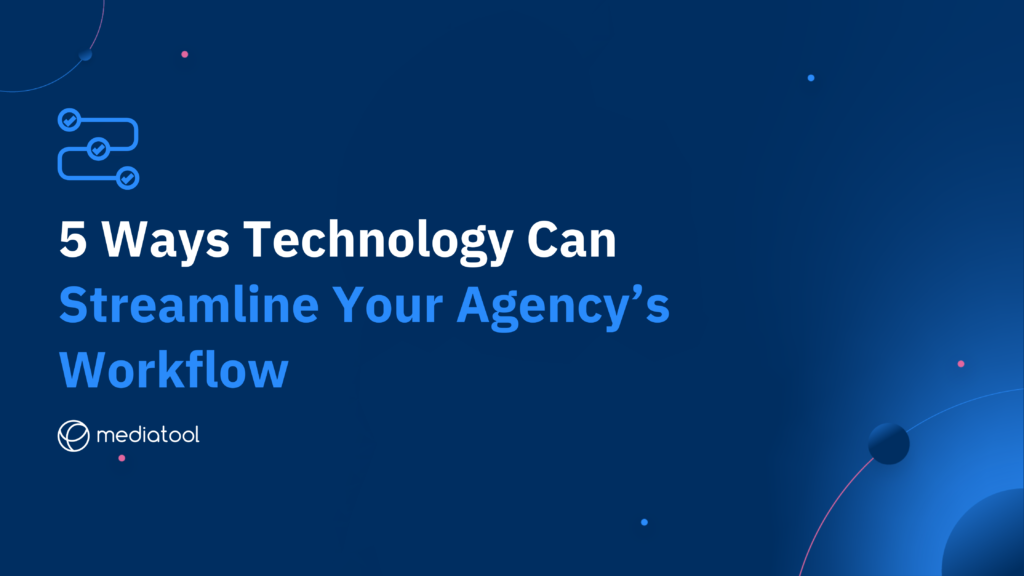Did technology kill the agency star?
There’s an ongoing debate in marketing agencies about the best way to manage resources in a highly automated, technology-powered world.
Forbes even weighed in, publishing an article that explained the risks of relying too heavily on technology to streamline workflows. It’s an insightful read. However, polarizing arguments that pit people against technology miss a crucial conclusion:
Technology and people must work together to streamline agencies.
The solution for agencies looking to streamline workflows and automate marketing processes is not replacing people with technology. It’s about getting the blend right. In other words, agency leaders should see marketing software as a tool to enable creativity, critical thinking, and collaboration.
Marketing automation tools eliminate time-consuming manual tasks and break down silos. That’s step 1 of streamlining workflows. Step 2 requires a thorough and collaborative review of the people and processes involved in delivering marketing campaigns.
How to Streamline Agency Workflows
Essentially, streamlining an agency workflow means:
- Removing unnecessary processes
- Optimizing operations
- Finding the most efficient way to deliver work
- Standardizing repeatable processes
- Continually seeking efficiencies
In the complex and often chaotic agency world, streamlining workflows is the foundation for growth. But even with superhuman processing power and time-saving automations, marketing workflow tools are not a silver bullet.
Technology supports agency teams to streamline processes in 5 key areas.
1. Strategy and Planning
The back-and-forth in strategic planning processes can chew up so much precious time! Collaborative, dynamic marketing planning processes remove the inefficiencies of meetings, strategic reviews, and feedback sessions.
The right marketing workflow tool will give your team the ability to:
- Collaborate and have conversations in real-time
- Invite clients to the planning process
- Share files and track versions
- Work across borders and time zones
- Approve strategic plans without scheduling a meeting
Streamlining the strategic planning process frees up time, shortening the campaign launch timelines and enabling collaboration along the way.
2. Campaign Development
Here we come to a Traffic Manager’s biggest challenge: managing resources. Once a client approves a marketing plan, the race is on to deliver inspired creative in the most efficient way.
Several workflows might occur in parallel, depending on the marketing mix:
- Creative
- Media planning
- PR and above-the-line messaging
- Digital/programmatic advertising
- Brand activations
- Social media engagement
Each workflow in the marketing mix has its own stakeholders and steps, spelling chaos for the Account Managers and Traffic Managers in charge of tracking the process and progress.
Marketing workflow software centralizes these processes, bringing agencies and clients together and breaking down silos.
When the combined team has visibility over KPIs, budgets, strategy, and past performance metrics, the runway to launching campaigns is not only shorter but more streamlined.
3 and 4. Measurement and Reporting
With the rise of real-time data feeds and short attention spans, campaign measurement is increasingly dynamic.
Monitoring data, generating insights, and turning those insights into action all need to happen fast, or you risk losing the customer’s attention. Therefore, the role of technology in streamlining agency processes here is twofold – but both happen in parallel.
-
Measurement
Marketing automation tools that collate diverse data can save agency teams hours.
Rather than exporting data, updating spreadsheets, reworking numbers, and juggling multiple documents at once, your team can simply log into a dashboard and access results on the spot.
-
Mid-campaign reporting
Marketing budgets are shrinking, and virtually every industry is becoming more competitive by the minute. Clients want to know how their campaign is performing week-by-week (even day-by-day).
Manually synthesizing all that campaign data and benchmarking against KPIs consumes a lot of resources. But you can streamline the workflow with a marketing automation tool. The key is setting clear targets and using a marketing management platform that tracks performance against those goals.
For example, agencies using Mediatool can monitor and compare results against targets at a glance, to gain actionable insights that improve decision-making. Mediatool also streamlines reporting processes by delivering tailored ROI reports in a few clicks.
5. Optimization
Let’s review how marketing automation platforms streamline agency workflows, saving time throughout the marketing campaign process:
- More efficient strategy and planning processes
- Shorter campaign development timelines
- Parallel workflows replace inefficient linear processes
- Automations save hours
- Dynamic real-time reporting
Channeling the time you save into creative ideation, campaign optimization, training, and strategy (depending on your marketing mix) results in better marketing campaigns.
These innovations, enabled by intelligent marketing automation tools, unlock the innovations that can move your agency forward and help you attract new clients.
Balance is Key: The Secret to Streamlining Agency Workflows
With the right marketing workflow management software and an empowered team, agencies can improve productivity, unlock award-winning creative potential, and deliver more impressive work. Agency leaders are responsible for equipping their teams with the tools they need to level up.
So the secret to streamlining agencies is not replacing human intuition with technology. It’s using one to improve the other in a cycle of continuous improvement, always chasing a better way to deliver inspired work.





